This past weekend I completed the two-day, 206-mile Seattle to Portland (STP) ride with my brother-in-law, Mike. This event is hosted annually by the Cascade Bicycle Club (CBC), and despite its daunting length, the ride sells out with 10,000 registered riders. Just to clarify, you read that correctly: every year ten thousand cyclists are willing to endure almost two-dozen hours of self-inflicted physical abuse for little more than bragging rights.
And this year, I was one of those masochists.
Prologue
I do not recall whether it was Mike or me who first suggested participating in this year's STP ride, but I am pretty sure that it quickly evolved into one of those "I'll do it if you'll do it" kind of conversations that guys often find themselves in. (And once the gauntlet has been thrown, you have to accept the challenge.) In any event, at some point back in 2014 we decided that riding in the STP seemed like a good [sic] idea, so I did some preliminary research about the ride on the CBC website. Once I had put together some rough details about the event, (e.g. when to register, where to stay, etc.), I sent everything to Mike. I let him know that the STP sells out quickly, so we both set calendar reminders to register on the day that registration opened.
When the starting day for STP registration arrived, Mike and I were both able to register for the event. Although in keeping with tradition, the STP was quickly sold out at 10,000 cyclists.
I received my official packet in the mail a few weeks before the ride, which brought a sense of reality the whole affair. My bib number for the ride was 8564, which was easy to remember, but it wasn't one of the numbers that I'd like to have. (e.g. I'd prefer to have something like 1024, 2112, 2600, 4096, 6502, 8088, etc. And no - I will not explain any of those numbers to you.)
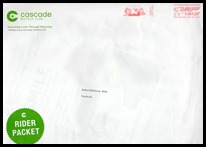 | 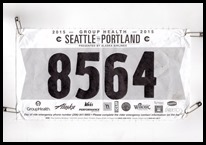 |
| My STP Packet! | Bib Number 8564! |
Once all of the event registration details were in place, I booked a hotel in Seattle for my stay before the ride, and Mike booked us a hotel in Centralia for the mid-point of the ride. After that, all that was left to do was buy a travel case for my bicycle, fly to Seattle to meet with Mike and his wife, Tesa, and prep our gear for the big day.
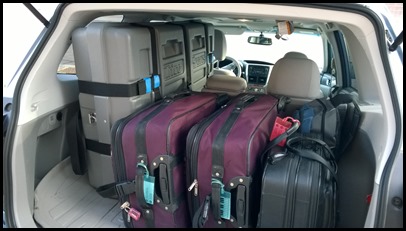 |
| Packing my gear into our car for the ride to the airport. |
 |
| Prepping my gear in my hotel room on the night before the ride. |
Day One - Saturday
Mike and Tesa picked me up from my hotel shortly before 5:00am, and we headed across the 520 bridge in Seattle to the University of Washington where the ride was scheduled to begin. As we neared the parking lot for Husky Stadium, we could see that there was a long line to get to the drop-off location, so I suggested that we pull into the parking lot across the street in University Village; this turned out to be the best idea and saved us lots of time. Mike and I got the last of our things ready for the ride, said our goodbyes to Tesa, and we rode to the start line.
 |
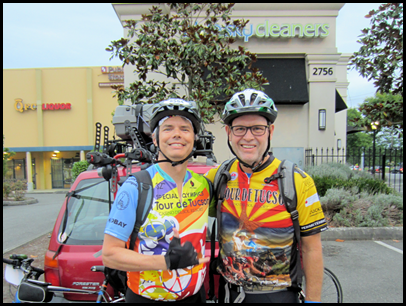 |
We dropped off our bags with one of the trucks that was headed to Centralia, and then we got in line for the next wave of cyclists. Note: In order to keep the hordes of cyclists from bunching up at the start, the event organizers combine riders into large groups and release them every few minutes; it was a very organized and efficient system. (One-day riders were allowed to start 30 minutes before two-day riders; this was also a great idea, because at a 16 mph pace that means that you could be eight miles away from the first wave two-day riders.) As we waited in the chilly morning air for our wave to start, Mike grabbed a quick cup of coffee, and we chatted for a few minutes until they announced that our group was ready to go.
 |
| Queuing at the Start Line. |
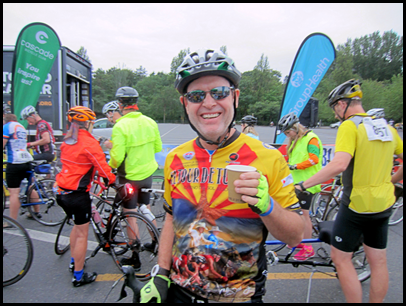 |
| Mike's last cup of coffee before the ride. |
When they pulled back the tape around 6:00am, I made sure to start both my Garmin GPS and the GPS app that I had written for my Windows Phone that allows family members to track our progress, and then we took off amidst a sea of exuberant riders.
 |
| Waiting to start. |
The first leg of our journey took us through a series of neighborhoods and parks that line the western shore of Lake Washington. The day was overcast, so we couldn't see any volcanoes, but it made the day cooler overall. There were a few small hills here and there as we started out, but nothing of significant difficulty.
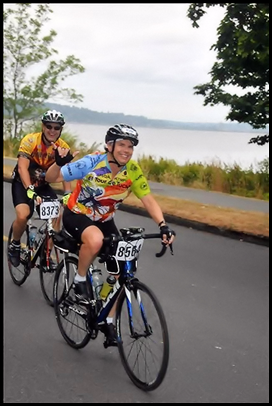 |
| Mike and I riding along Lake Washington. |
Mike and I had set our goal for the morning to ride straight through to the 40-mile stop in Puyallup, so we quickly bypassed the first official stop at Seward Park around the 10-mile mark. (Actually, I couldn't believe that anyone was bothering to stop there; we were barely a half-hour into the ride.) I should mention that I pushed Mike's and my pace pretty hard at the beginning of the day for the first hour or so; I wanted to get past several groups of slow-moving cyclists, and that way we would be riding with more of the serious cyclists who would keep a better pace.
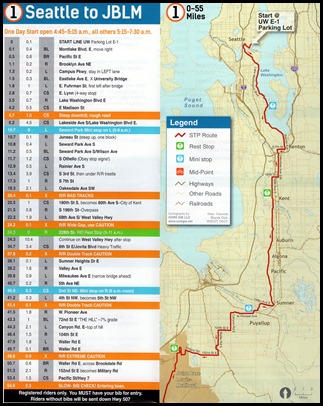 |
| Route map for the first half of Day 1. |
Shortly after we passed the 24-mile stop in Kent, Mike and I pulled up to a stoplight with a hundred or so riders. I unclipped my left foot so I could stand on it while waiting for the light to change. But as I came to a stop, I suddenly lost my balance to the right, and I couldn't unclip my right foot before I fell over. (Thankfully I was wearing a helmet when I hit the ground.) There were a half-dozen or so concerned cyclists surrounding me and asking if I was okay, but I chose to reply by jumping up and addressing the entire crowd of cyclists by exclaiming, "Nothing wounded but my pride, folks! Did anyone get that on video? I'd like to post it online later." This had the desired effect of assuring everyone that I was all right while allowing everyone the opportunity to laugh along with me at my own expense. However, this little mishap left a lovely, little series of gashes on the back of my left leg, and I got lots of comments about it for the rest of the day. (e.g. "Nice tattoo!", "Blood and grease make great lubricants!", etc.)
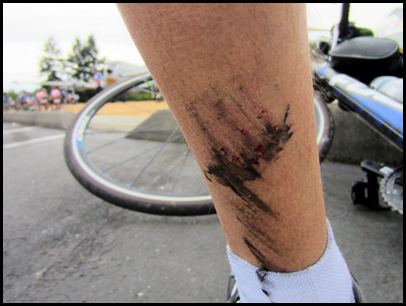 |
| My first War Wound of the day. |
A couple of hours into the ride we had passed the one-third point for the day, and I tried something kind of stupid: I pulled out my camera and held it backwards over my shoulder in order to snap a few photos of Mike. All of the photos came out pretty well, but just the same - I resolved not to try that again.
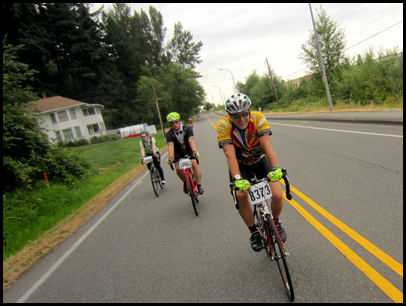 |
| Mike looks pretty good after two hours of riding. |
We arrived at the 40-mile stop in Puyallup around 8:30am, and it was nice to get off the bike for a few minutes and walk around. Mike and I refilled our water bottles, ate some chocolate cookies that were for sale, and we split a banana. (Bananas are a good source of potassium, which helps cut down on muscle cramps.) After a quick 10-minute break, we hopped back on our bikes and headed south towards Portland.
 |
| Taking a quick break in Puyallup. |
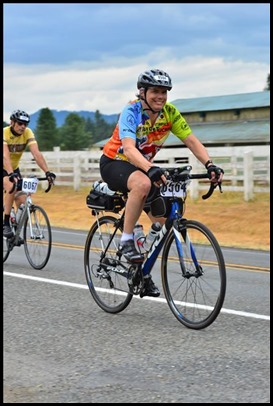 |
| Back on the road. |
I knew from looking at the elevation profile before the ride that the largest hill climbs of the day were immediately ahead of us, and we hit the base of the first hill somewhere around the 44-mile point. As Mike and I made our way up the hill, Mike found a great opening amidst the mass of cyclists and attacked the hill with some serious gusto. Unfortunately for me, however, I managed to get myself boxed in by a group slow-moving cyclists. By the time that I managed to maneuver my way past them around the mid-point of the first hill it was too late; I had lost all of my initial momentum to launch a proper attack, so I was forced to slog my way up the first hill. I was still passing scores of cyclists, but I should have been moving a lot faster. (Darn. Darn. Darn.)
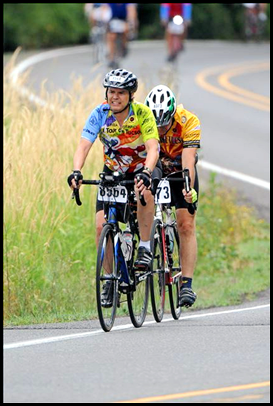 |
Once Mike and I were past the big hills for the day, (which comprised about four miles of the day's riding), it was fairly easy cycling for the next ten miles to the 57-mile stop at Joint Base Lewis McChord (JBLM), where lunch awaited us. (Note: There were some serious winds as we rode around the base's airfield; that was no fun.) We arrived around 10:00am, and we were pleased to discover that there was a fairly decent spread of food at this stop; I had a turkey sandwich, a Rice Krispy Treat, some fruit, another cookie, etc. But to be perfectly honest, by this point I was so ravenously hungry I could have eaten just about anything. After resting for 20 minutes, Mike and I refilled our water bottles and we got back on the road.
 |
| Hundreds of cyclists taking a lunch beak on JBLM. |
 |
| Mike and I taking a quick photo before heading out. |
As we weaved our way through the base housing, that brought back memories of being raised as a kid on various military bases, and also of my own years serving in the military and living on base. (Note: Those nostalgic reminiscences weren't necessarily happy memories for me, because base housing usually leaves a lot to be desired.) Anyway, many of the cyclists were giving high-fives to the MPs and other military personnel who were directing traffic for us. They were all enlisted personnel, so I'm sure that most of them were ordered to guard the roads for the cyclists, but nevertheless their efforts were greatly appreciated by all of the riders.
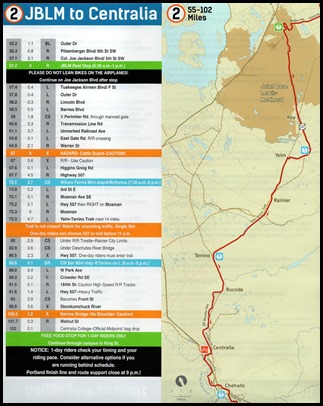 |
| Route map for the second half of Day 1. |
The route took us through some of the back woods on the base, and eventually we exited the base near the town of Roy, WA. Mike and I pressed on to McKenna, which was the next official stop at mile 72 for the day. We arrived around 11:40am, and we took a break to rest our weary legs for about 20 minutes. After we refilled our water bottles, it was time to head out.
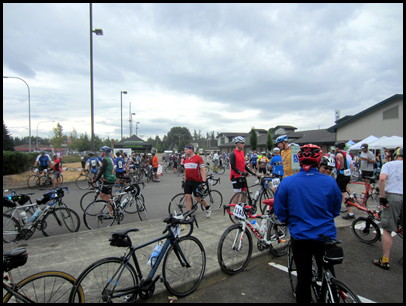 |
| Stopping briefly in McKenna |
Shortly after we left the stop at McKenna, we faced a steep hill climb. Mike was ahead of me, so he didn't notice the following incident: I attempted to shift from my top chain ring to my small chain ring in order to climb a little easier, but my bicycle threw its chain off the small chain ring. I tried to backpedal out of the situation, but my chain became completely lodged and it wouldn't move. This predicament caused me to quickly lose all of my forward momentum in the middle of the hill, and in one of those moments that seems like an eternity at the time (but was really just milliseconds) I weighed my options. There was obviously nothing that I could do to dislodge my chain, but if I unclipped my left foot (which I always unclip) I would be leaning (or falling) into traffic. This risk was unacceptable, so with no other options available to me, I threw all of my weight to the right side of the road, where my bicycle and I tumbled over the concrete curb and into the grass and dirt that lined the road. This undoubtedly looked much worse than it felt; several approaching cyclists called out to me to see if I was okay. I assured everyone that I was fine, (although my fall had bruised my right arm and torn up my right knee a little). I explained that my bicycle had simply thrown its chain, and I encouraged everyone to continue pedaling uphill. After that, I spent the next 10 to 15 minutes attempting to untangle my bicycle chain. This proved to be a very difficult task; my chain was stuck fast, but I eventually succeeded - although my hands were filthy by the end. (It's a good thing that I had packed hand wipes with me.) Mike eventually noticed that I was nowhere to be seen, so he pulled off the road into an unofficial stop at mile 81 and sent me a text message to let me know that he was waiting for me. When I caught up with Mike, I explained what had happened, then we quickly got back on the road.
 |
| My second War Wound of the day. |
The next segment of the ride Mike and I both agreed was the best part of the day's ride; we rode along the well-paved Yelm-Tenino Trail for 14 miles or so. First and foremost - there were no cars on the trail, which was a pleasant change. In addition, the trail was wide enough for Mike and I to ride together, and yet there was still enough room for other cyclists room to pass when necessary. This trail was also the smoothest part of the day's ride, which was greatly appreciated.
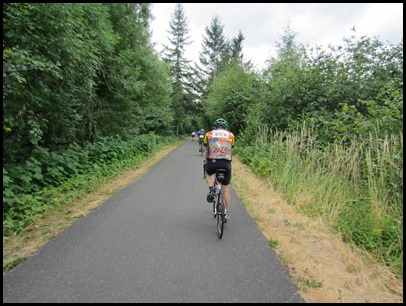 |
| Riding along the Yelm-Tenino Trail. |
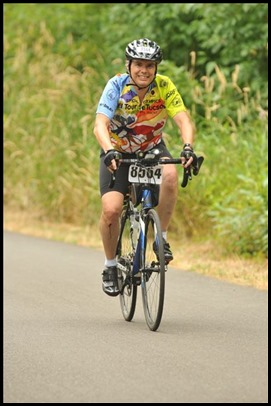 |
Note: As we were riding along the trail, Mike and I saw the aftermath of a female cyclist who had suffered some sort of major catastrophe; medical personnel were treating her myriad injuries, and I make no exaggeration by stating that she was covered in blood.
Mike and I stopped in Tenino at the 89-mile point around 1:25pm, which was the last official stop before our destination for the day in Centralia. Our decision to stop in Tenino was mainly due to my earlier accident; I wanted to have some bicycle repair technicians check out my bike to see if they could determine why it threw its chain. The technician ran my bike through all of its gears but couldn't reproduce the problem, so he commented that it must have been a fluke. His diagnosis put my mind at ease, although that later proved untrue. (But I'm getting ahead of myself.)
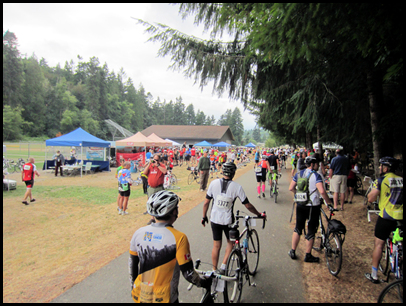 |
| Taking a break at the Tenino stop. |
When Mike and I left Tenino, we had only 14 miles to go for the day, and the miles passed pretty quickly as we rode for the next hour or so. (To be perfectly honest, I can't recall anything of importance from that hour's worth of riding.)
 |
| Finishing up the day's ride. |
We crossed the Day 1 finish line at Centralia College shortly before 3:00pm, so we made pretty good time for the day. My wife, Kathleen, had been tracking our progress throughout the day via the GPS app that I had written, and she sent me a text message to congratulate Mike and me for completing the first day's ride.
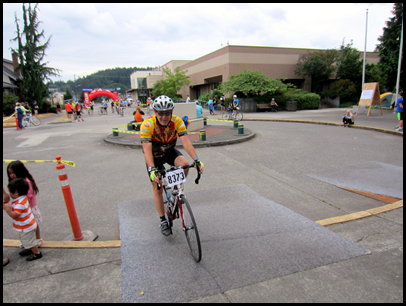 |
| Mike crossing the Day 1 finish line. |
As various cyclists made their way across the finish line, an announcer was having fun calling out the various jerseys and costumes worn by the participants. Mike and I pushed our bicycles out of the way to allow arriving cyclists more room to exit the course, and as we did we were met by volunteers who were handing out orange-flavored popsicles. Mike and I both gladly accepted the proffered popsicles, although at that point the volunteers could have frozen just about anything and I would have eaten it. (e.g. "Here's your frozen kale!", "Get your frozen lutefisk here!")
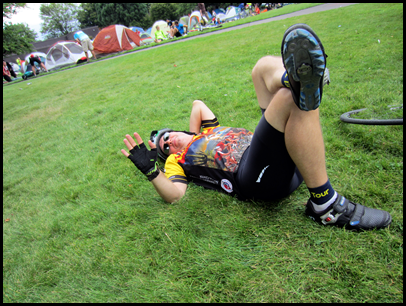 |
| Mike enjoying some well-earned reclination. |
After a little rest and relaxation, we decided that we should either find something to eat for dinner, or we should depart for our hotel. We looked at our dining choices, and we chose to order a pizza at the hotel later. Our next step was to retrieve our backpacks, and it took us a few minutes to discover where the pickup point was located. (This was due to a misunderstanding of what the announcer said.) Once we found the right place, it was well-organized and we quickly found our things.
Our hotel was a little less than two miles from the college, and once we got settled into our room we both took long showers to wash off the grime from the day's activities. We ordered a pizza to be delivered to our hotel room - which was fantastic. We ate most of the pizza, but we set aside two pieces for breakfast the following morning. (For some people, cold pizza in the morning is the breakfast of champions.)
After dinner we put together our riding plan for the next day, and I wrote up a cheat sheet with the distances for all of the stops. The pickup up time for our backpacks at Centralia College wasn't until 6:00am the following morning, so we both set our alarms for 5:00am, and we headed off to sleep by 8:00pm.
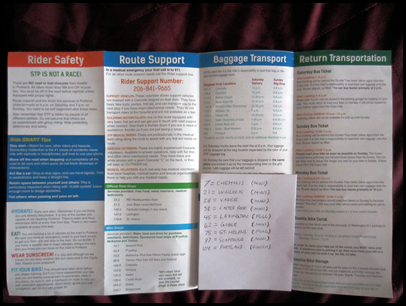 |
| Putting together my cheat sheet for the next day. |
We had averaged a little over 15 mph for the day, which wasn't bad. Here are some quick stats for the first day's ride:
- Total Distance: 102.1 miles
- Riding Time: 6 hours, 39 minutes
- Total Time: 9 hours, 4 minutes
- Elevation Gain: 3,290 feet
- Average Speed: 15.4 mph
- Calories Burned: 3,444 kcal
Day Two - Sunday
Mike and I both woke up shortly before our alarms, and since neither of us could sleep, we got up and started to put our things together for the day. We pulled the pizza out of the mini-fridge from the night before, although by now neither of us wanted to touch it. (It's funny how appetites can change overnight.)
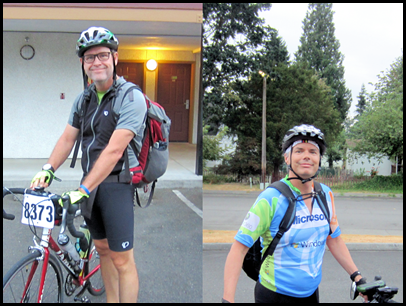 |
| Mike and I preparing to start our Day 2 ride. |
We got on the road by 5:40am, which was close to our goal. As we pulled up to a stoplight near the hotel, I pulled my bicycle onto the sidewalk in order to push the button to change the traffic signal. Unfortunately I decelerated too quickly and - surprise, surprise - I lost my balance and fell over. Seriously - one minute into the day's ride and I had already fallen over. Who DOES that? (Apparently I do. And just to clarify, my count for falling over during this trip was now at three. Darn.)
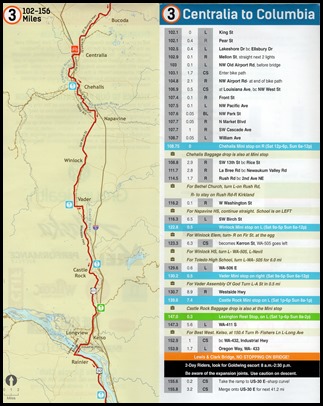 |
| Route map for the first half of Day 2. |
Mike and I arrived at Centralia College within ten minutes of leaving our hotel, and we quickly dropped off our backpacks. Once that task was taken care of, we got on the road shortly before 6:00am. Even though my muscles were a little sore when we got up and headed out from our hotel, much of that soreness quickly passed as we started the actual ride.
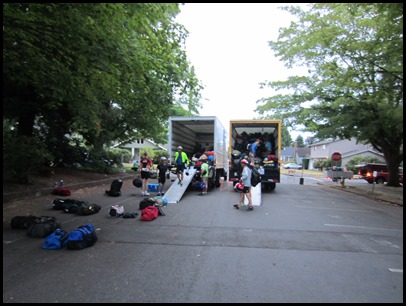 |
| Dropping our backpacks off at Centralia College. |
We skipped the first stop in Chehalis at the 7-mile point, but as we rode through town we realized why some of the more experienced STP riders push on to Chehalis or some other town during the first day; it diminishes the length that you need to ride on the second day, and it probably helps psychologically to know that your ride will be shorter. You would miss out on all the half-way point festivities in Centralia, of course, although you could hang out there for a half-hour or so before riding on to your ultimate destination.
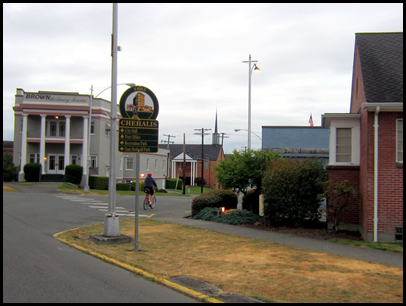 |
| Riding through Chehalis in the early morning. |
Our plan for the day was to ride a little slower than the previous day and to hit all of the stops. We had made good time the day before, but we didn't want to kill ourselves during the second day's ride. With that in mind, Mike and I started off together, and the road was wide enough for us to carry on a conversation as we rode. Sometime later I started to break away on the hill climbs, and at the next stop Mike suggested that I ride at my own pace and simply wait for him at each successive stop. With that in mind, I routinely sped off after each stop, but I only arrived at each stop about two or three minutes before Mike, so he was riding at pretty much the same level as me. What's more, Mike passed me during a couple of the hill climbs and I somehow didn't notice, so I was perplexed when I found myself passing him later. ("Hey, how did you get here?") Once I discovered to my amusement that Mike was waiting at the next stop for me, and I queried when he had managed to pass me; Mike replied that he had passed me following a climb, and he had arrived at the stop just 30 seconds before me.
At one point I was passing a bunch of cyclists and I kept hollering "On your left" to announce my intention to pass each cyclist. I started hearing a woman behind me announcing the same as we passed several cyclists, so I thought she was drafting behind me. But as I was passing another cyclist the woman behind me exclaimed, "I'm not kidding; ON YOUR LEFT!" This meant that she wanted me to get out of her way, but I need to point out that there was no shoulder on the right, so the cyclist to my right had nowhere to go. I was in the middle of our lane passing that cyclist with only inches to spare between our bicycles, whereas the woman behind me had the rest of our lane and the entire oncoming traffic lane (with no traffic visible for at least a mile) with which to pass me. As I couldn't get out of the way without pushing the cyclist to my right off the road, I ignored the woman behind me. When she eventually pulled alongside I remarked, "In case it wasn't obvious, I was passing someone, too. Just a thought." (I got no reply as she sped off.)
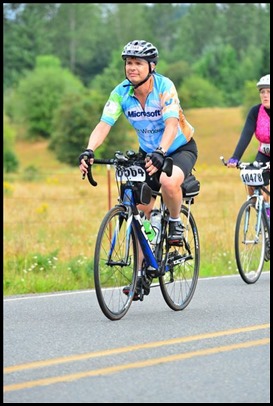 |
I knew from studying the ride profile the day before that we had a big hill awaiting us near the start of the day, and sure enough we hit the base of the hill around the 14-mile point. However, this hill was a little different than the big hill on the previous day, because it was more like a series of hills that seemed to go on and on for five or six miles, and for a little while it became kind of annoying. (Well, it was annoying for me, anyway.) But I was really glad that I train on the Pistol Hill Loop back in Tucson, which has a long, uphill climb for seven miles or so. As I was riding I kept thinking about Rule #10 from The Rules: "It never gets easier, you just go faster." (Of course, Rule #5 always applies, too.)
That being said, as I attempted to shift my bike onto the smaller chain ring, my bike threw its chain again. But since I had a sneaky suspicion that it might do so, I chose a time to shift when few people were near me, and when my chain was thrown I was able to quickly pull to a stop and get off the road in a controlled manner. A few of the passing cyclists asked if everything was okay, and I replied, "Yup - I just threw my chain." They just nodded sympathetically and rode on. It took me about five minutes to fix my chain, and once I had done so I wondered what to do with all the oil on my hands. I decided that my cycling shorts were black for a reason, and I just wiped my hands off on them.
Rejoining a hill climb in the middle is tricky; you have to find a good gear to get started, and you have to find a good interval between cyclists to get back on the road. Nevertheless, I managed to get back on the road pretty quickly.
As we neared the summit of a really tough climb, I loudly asked everyone around me, "Why are we doing this? Is ANYONE having fun?" Most people just laughed, but the woman riding next to me said this was the best thing that had happened to her all year. I replied, "Really? This climb is the best thing that's happened to you this year?" She responded, "Yeah, I've had a really awful year." (I said I was so sorry for her; and I really meant it.)
Our first official stop of the day was in Winlock around 7:15am. Mike and I both bought a small cup of coffee, and we split a simple breakfast sandwich. (Which at the time tasted better than filet mignon.) As we arrived, medical personnel were loading an injured cyclist into an ambulance, which was yet another reminder that I was fortunate that my previous day's injuries had been pretty minor.
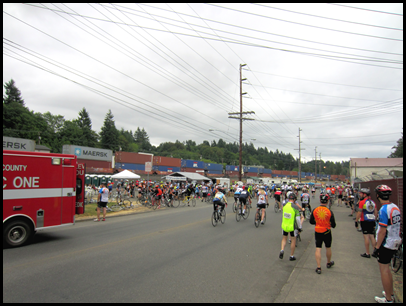 |
| Arriving in Winlock. |
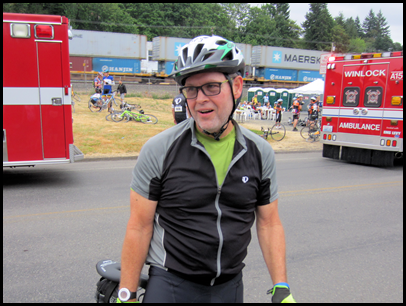 |
| Thankfully the ambulances were not there for us. |
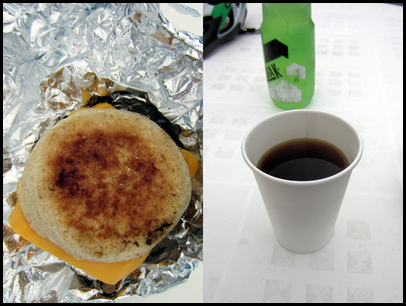 |
This may not have been the breakfast
of champions, but it was fantastic. |
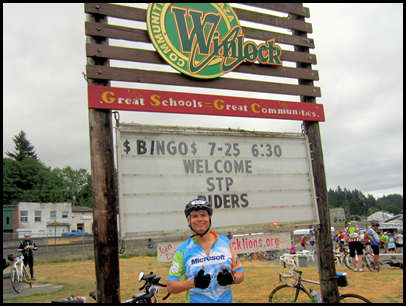 |
| Mike insisted on this photo. I kind of regret it now. |
The next official stop was in Vader (no relation to Darth) at 8:20am, but Mike and I were both feeling pretty strong so we decided to bypass this stop and we hopped back on the road in order to push on to the next stop.
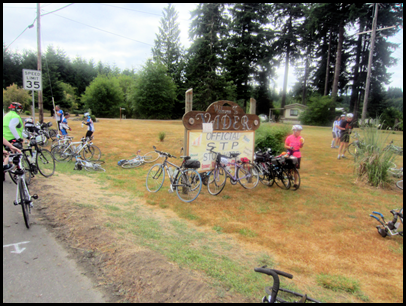 |
| Bypassing the mini-stop in Vader. |
The sun broke out, which made it much warmer, and I finally had a need for my sunglasses. Some of the cyclists complained about the heat, but it was cooler than my usual riding temperatures in Arizona so I didn't mind. (Although I did increase my water intake.) Unfortunately, since the first day had been overcast, Mike had packed his nice sunglasses for this trip, so he only had his normal glasses with him. (Even though his normal glasses automatically tint in sunlight, it's just not the same.)
We pulled into Castle Rock around 9:00am, which was the 38-mile stop for Day 2. I think Mike may have refilled his water bottles, but I was doing fine for supplies so I just stretched my legs for a few minutes before we got back on the road.
 |
| The stop at Castle Rock. |
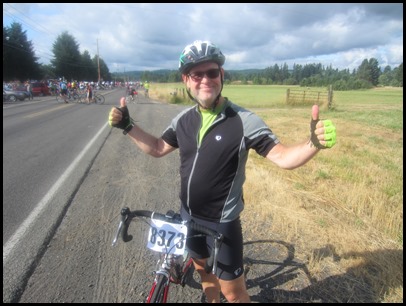 |
| Mike expressing his elation upon our arrival. |
 |
My bike leaning against a rock in Castle Rock.
It might have been the actual "Castle Rock," but I couldn't be sure.
(Note: That was meant as a joke, of course.) |
The next stop was in Lexington at the 45-mile point, which was the first major food stop of the day. We arrived at 10:00am, so we were a little behind a timeline that I would have liked. But we had kept our pace pretty well; we had simply been following our plan to hit more of the stops along the way, which slowed us down a little. However, this approach was arguably worth the sacrifice from a psychological perspective; it was nice to know that our next stop was never more than 10 to 15 miles away, even if we decided to skip it. In any event, Mike and I ate a leisurely lunch in Lexington and we relaxed for a while before getting back on the road.
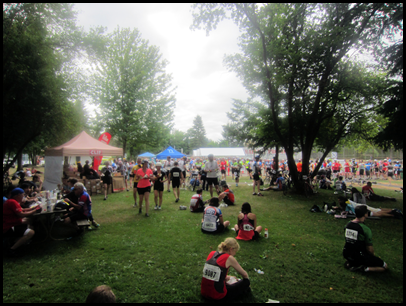 |
The Lexington stop had a much larger crowd
than normal, but that was to be expected. |
 |
| Mike enjoying lunch. |
Unfortunately we discovered as we got ready to leave the Lexington stop that there was a really long line to refill our water bottles, so that set our departure time back a little. Apparently there was a problem with the water pressure, so they only had a single tap working for hundreds of cyclists. (If we had known that fact a little sooner, we could have got in line when we arrived. But in the grand scheme of things it wasn't that much of an imposition; and we were glad to have enough water to depart safely.)
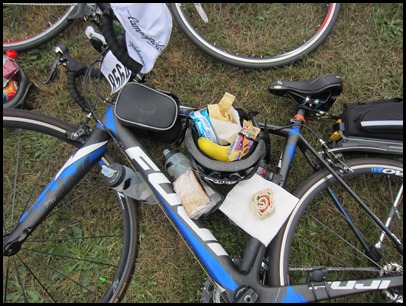 |
Sorting through the food that I picked up and choosing what
comes with me on the road and what gets eaten immediately. |
Mike and I got on the road around 11:00am, and about a half-hour later I arrived at the Lewis and Clark Bridge over the Columbia River, which signified the border with Oregon. The ride organizers and police were corralling cyclists onto a frontage road while allowing southbound road traffic to continue over the bridge unabated, with the intention of stopping traffic at some point and allowing the mass of cyclists to make their way across the bridge. Mike arrived about ten minutes after me, so he was further back in the mob of bicyclists than me. About ten minutes after Mike arrived the police finally blocked off the traffic and allowed the cyclists to cross the bridge; this action was greeted by a number of cheers from the assembled throng of cyclists.
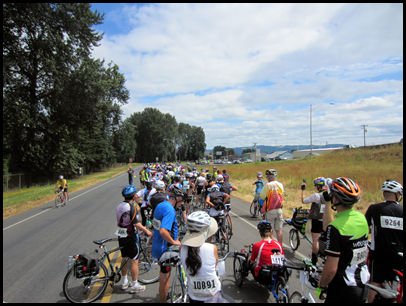 |
The hundred or so riders who had
arrived at the bridge before me. |
As we approached the bridge, several of the ride organizers called out to the crowd to say that the descent on the opposite side of the bridge was going to be very bumpy. With this in mind, they were recommending that everyone should make sure that all of their gear was securely fastened to their bikes, and to watch out for lost gear as they descended. I reached down and made sure that my water bottles were snugly fastened into their cages, and I made my way up the bridge climb.
I have to admit, when I first saw the bridge from a distance, I thought that the climb would be exceptionally terrible. But as it turns out, the climb wasn't that bad. However, what was bad was that there was a large number of cyclists who were riding very slowly, but we had been grouped into such a thick horde of cyclists that it was difficult to maneuver around the slow-moving riders. Meanwhile, we had fast-moving traffic approaching in the opposite direction. As a result, the ride across the bridge was often terrifying - just for fear of accidents. (PS - some people simply gave up and walked their bikes across the bridge.)
 |
| The Lewis and Clark Bridge from a distance. |
As I approached the mid-point of the bridge, the crowd around me had thinned out considerably. A group of cyclists (including me) had broken away from the main group, and as a result I had enough of a buffer behind me that I felt comfortable enough to pull out my camera and snap a couple of photos before starting my descent. As I coasted down the far side of the bridge, I put on a lot of speed due to the steep decline, so I was braking constantly as I hit the series of bumps about which we had been warned. True to the predictions, there were somewhere between 50 and 100 water bottles lying beside the road. I guess some people failed to heed the warnings. Once we were past the bridge, we were back to road riding - only now we were in Oregon.
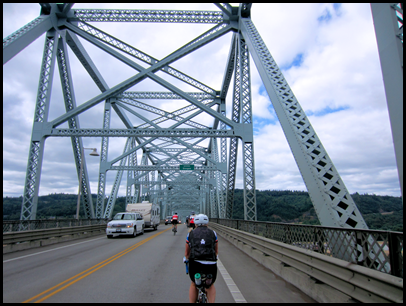 |
| Entering Oregon! |
Sometime later my bike threw its chain again, and this happened a few more times. However, each time I was able to catch the problem before I wiped out, and I pulled to the side to fix the problem. (I waved Mike on whenever this happened.) But I decided that I no longer trusted my bicycle to shift to the small chain ring, so I chose to ride for the rest of the day on my small chain ring in order to avoid throwing my chain again. (This is, of course, unacceptable for a bicycle, so I resolved to have to have that looked at when I got home.) However, this also meant that I forfeited my highest gears, and therefore I lost my top speeds.
After a while I had so much oil and grease on my fingers due to resetting my chain that it was kind of gross to eat. That being said, there simply wasn't a place to properly wash off all of the fifth, so I was forced to make do. (In my military days I called this condition "perma-grime," and I learned to live with it or starve.)
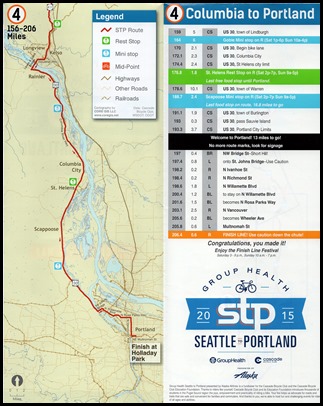 |
| Route map for the second half of Day 2. |
At some point during the day I started to ride with a group of women with Skull/Butterfly gear. We rode together for quite awhile because we seemed to ride at the same pace for the flat sections; I would climb hills faster than them, but they were willing to take the downhills faster than me. I can't remember when we started riding together, and I can't remember when we stopped. It was probably at one of the stops, but I don't recall.
Mike and I stopped in Goble at the 62-mile point around 12:30pm, although we didn't stay long. We refilled our water bottles, and I had a couple snacks that I had saved from an earlier stop that day. After 10 minutes or so we were back on the road.
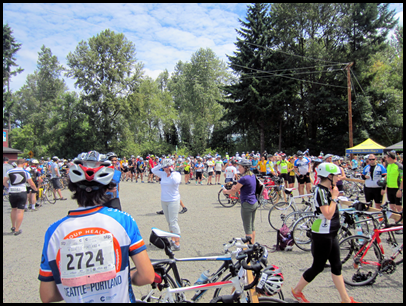 |
| Stopping for water in Goble. |
The next big stop of the day was in St. Helens, which was shortly before the 75-mile point. We arrived around 1:50pm, and we found a good place to ground our bikes while we wandered off in search of food. The sandwiches and snacks were largely the same as other stops, except that they had watermelon, which was fantastic. They also had a water mister operating, and it was fun to see people walk through it again and again.
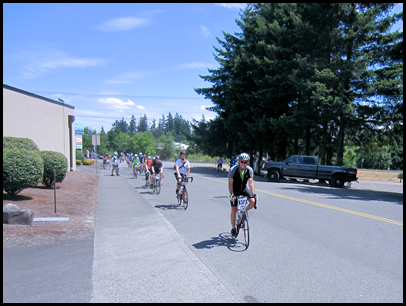 |
| Mike pulling into St. Helens. |
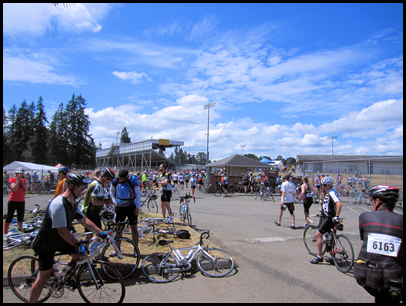 |
Navigating through the sea of
cyclists to find our lunch. |
Mike needed to pick up something from the medical tent, and one of the volunteers asked if I wanted her to wrap my knee from the previous day's accident. I replied, "No, I earned that." (She laughed and walked away.) After an hour's rest, we packed our things and got back on the road.
 |
| Visiting the medical tent. |
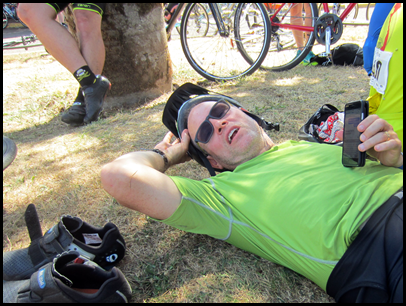 |
| Mike leaning back, kicking his shoes off, catching some shade... |
Somewhere after we left St. Helens, I realized that I had not been pulling up on my legs during the climbs; I had just been pushing down. So I decided to change pedaling techniques, and I discovered that I had so much power in reserve that I found myself climbing a few of the difficult hills at 18 to 20 mph. That being said, I realized that this was going to be a short-lived discovery; after a few hills I recognized that I was quickly burning up that reserve, and all of it was gone by the time I hit the uphill climb to St. John's bridge an hour or so later.
 |
Our last stop of the day was in Scappoose at mile 87, and we arrived around 3:30pm. This stop was pretty small; it was really just the last chance to fill up on water before starting the final 17-mile stretch to Portland. Kathleen sent me a text message that the GPS app that I had written had stopped uploading data at Goble, so I quickly reset it and it started transmitting again. (If Kathleen hadn't sent me that message I would never have known, and Kathleen would have thought that something had gone wrong in Goble.) After Mike and I topped off our water bottles, we got back on the road.
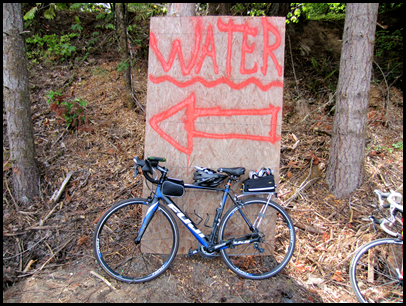 |
| My bike was helping to point the way to water. |
 |
| Taking stock of my snacks for the final push. |
Mike later remarked that he started to listen to music through his iPhone about three or four hours from the end of the ride, although I didn't turn on my music until the last hour or so before the St. John's bridge. (Then I turned off my music for the ride through Portland.)
Mike and I had agreed to meet up at St. John's bridge, which crossed the Willamette River into Portland, in order to finish the ride together. The distance from Scappoose to the finish line was roughly 16 miles, and the bridge was about midway between the two locations, so from a psychological perspective it helped to subdivide the last of the ride into two shorter segments. (At this point in the ride, it's all about the mind games.)
I arrived at the bridge less than a minute before Mike, who pulled along side as I took a photo of the bridge. We had to wait for a stoplight to change, and then we made our way across the bridge with a small group of cyclists.
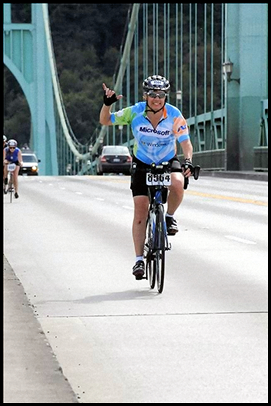 |
| Crossing the St. John's bridge into Portland. |
The ride through Portland was predominantly a nice respite from all of the up and down hill riding over the past several days, except that there was one small hill near the finish line that was a brief moment of difficulty, for which I loudly remarked, "Okay, who added THIS hill to the ride?" That being said, we were forced to stop for a large number of stoplights as we rode through Portland, which probably added at least a half-hour to our ride time.
Nevertheless, before we realized it, Mike and I were crossing the finish line at Holladay Park, and our second century ride of the STP was over. (Note: I should have taken off my sunglasses as I crossed the finish line, because you probably can't see my face in official ride photos. But perhaps that's a good thing.) Mike and I were handed our "STP Finisher" patches, and then we pulled our bikes off to the side to allow room for arriving cyclists who were completing the ride.
 |
| Approaching the last few meters to the finish line! |
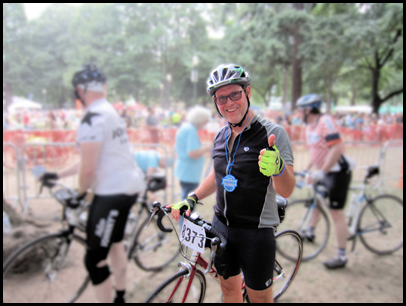 |
| Mike's opinion of what it feels like to finish. |
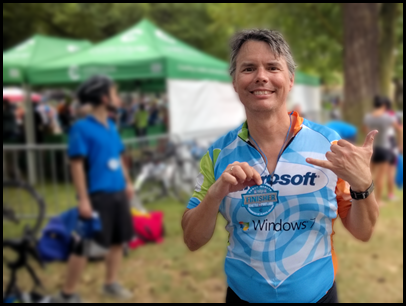 |
| Proudly displaying my hard-earned "Finisher" patch! |
We walked our bikes through the crowds, and we found a tree off to the side of the park on which to lean them. Mike watched our bikes while I picked up our backpacks.
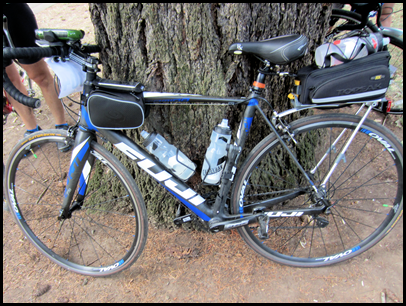 |
| My bike finally earned its own rest. |
Shortly thereafter we were met by Tesa and her sister, Mary, who showed up to congratulate us. After a few minutes of visiting with Mary and Tesa, Mike and I ventured off in search of something to replace the thousands of calories that we had just burned.
We decided on Greek Gyros, (which were amazing), and we picked up some free souvenir STP cups from the Cascade Bicycle Club. After that, Mike and I ordered our 2015 STP jerseys. (Note: I don't pre-buy my jersey before a ride, which is kind of like a minor superstition for me; I don't want to jinx the ride by buying the jersey and then failing to complete the ride.)
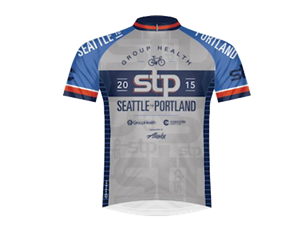 |
| What this year's jersey looks like. |
We were informed that we won't receive our jerseys until October, which was unfortunate, but what choice did we have? Once we were done eating and buying our jerseys, we packed up our bikes and headed off to spend the evening with family.
Mike and I had averaged just under 15 mph for the day, which once again was pretty good. Here are some quick stats for the second day's ride:
- Total Distance: 106.2 miles
- Riding Time: 7 hours, 8 minutes
- Total Time: 11 hours, 39 minutes
- Elevation Gain: 3,809 feet
- Average Speed: 14.9 mph
- Calories Burned: 3,954 kcal
Epilogue and Random Thoughts
I had jotted several things down in my notes that didn't apply to either day in particular, so I thought that I would add a special section to this blog in order to share them.
- Ford Prefect described Earth as "Mostly Harmless." If I was following his lead, I would label STP Day 1 as "Mostly Flat," and STP Day 2 as "Mostly Hills."
- Mike and I saw several bad accidents during the ride, with several people being whisked away in ambulances. So in the grand scheme of things, my minor injuries were nothing. (Although it should be noted that Mike had no injuries; only I did.)
- Throughout the ride, most cyclists did their best to thank the volunteer staff and police officers who provided food, drinks, directed traffic, etc.
- Two words: Honey Buckets. Enough said.
- On Day 1, Mike and I both wore our El Tour de Tucson jerseys, and Mike got lots of comments about his jersey. It was from the 2012 El Tour, and I have to admit, that year had my favorite artwork; it appears that everyone else agrees with me.
- On Day, 2 Mike wore a plain jersey while I wore a Microsoft jersey. At some point another cyclist from Microsoft noticed my jersey, and we started a small conversation as we rode. The guy asked me if I work on Visual Studio, since that logo was on my jersey, and I replied, "More or less." (I work in the division that creates Visual Studio, and I designed the development web server that ships with Visual Studio.) I asked where he works, and he replied, "I work on HoloLens." I said, "Dude, you work on the cool stuff." To which he responded, "Yeah, and I use your stuff to make my stuff."
- I had several groups of cyclists touch on one of my pet peeves: they failed to queue properly at a stoplight. In several specific instances, a group of cyclists was already queued at a stoplight, when an approaching group of cyclists would glide past the whole queue in order to take the best position for when the light changes. This was especially frustrating to me when it was a group of cyclists that I had already passed, which meant that I would have to pass them again! (If I recall correctly, I politely chastised a couple of groups of cyclists for failure to queue properly. After all, we were in it together, right? Weren't we supposed to cooperate? Sheesh.)
- Unlike the El Tour de Tucson, which has thousands of people cheering cyclists on, most of the Seattle to Portland course was devoid of anyone other than angry motorists who appeared to hate the inconvenience of cyclists taking up their precious roadways.
- Some groups of fast-moving cyclists speed up on your left side unannounced and it scares the poop out of you. (I did my best to announce all of my passes.)
- We saw some interesting bicycles on this ride. For example, one group of cyclists riding for charity were doing the entire ride on vintage, single-speed bicycles. (That's either gutsy or foolish - but either way I admired their bravery.) I saw two cyclists on commuter bikes that resemble Brompton Folding Bikes, which was even more insane than riding a single speed bike. There were also a few recumbent bikes completing the ride, several tandem bicycles, a Penny-farthing, and one hand-pedaled cyclist who was making pretty good time.
- At most of the stops (full and mini) they had water, Clif bars, and sometimes fruit, while at the full stops they also had sandwiches a greater selection of snack foods. The full stops also had lots of vendors selling their wares or offering free samples.
- I over-packed for my supplies, but that's actually a good thing; I would rather have something with me and not need it than to need something and not have it.
- There is an old adage that says, "If you ain't the lead dog, the view never changes." This applies to cyclists as well.
- I made good time for a lot of the ride; I was able to keep a pretty good pace even climbing the moderate hills, and I found myself climbing with a good deal of power. (I was nowhere near competitive, of course, but I was really glad that I always train with hills.)
- After the ride was over I did the math, and I could have done the ride in a single day if I started at 4:45am with the rest of the single-day riders. Now I am not suggesting that I wouldn't have been in a great deal of pain after the ride, and during the ride I would have been psychologically punishing myself for being stupid enough to attempt a 206-mile ride in one day, but the math definitely proved to me that it could be done by me. (I should point out that I am not suggesting that I ever intend to do such a thing, but it is possible.)
- Throughout the ride I tried to joke around with other cyclists; I complimented people on their jerseys, silly things they attached to their bicycles or helmets, funny costumes, etc. I tried anything to take people's minds off the immediate suffering that we were all experiencing. I used to do the same thing in my Army days; I am not trying to be a "comedian" and make people laugh - I am just trying to spread a little joy and alleviate a little pain when it's needed most.
- Mike later made fun of me for a few of my verbalizations to other cyclists during the ride. For example, I chastised one guy for tossing a plastic wrapper to the ground: "Dude, you should pack out your own garbage." (Note: I always do.) And I chastised someone else for cutting me off with an abrupt lane change: "A little warning next time would be great. Thanks."
- I alluded to this earlier, but several of The Rules applied during this ride; I mentioned Rules #5 and #10 earlier, but the more you ride, you start to realize how many of those rules are apropos for any big riding event.
At the end of the event, Mike and I averaged just over 15 mph for the entire ride, which was better than I had anticipated during our planning. Here are some quick stats from both days:
- Total Calories Burned: 7,398 kcal
- Total Elevation Gained: 7,099 feet
- Final Average Speed: 15.1 mph
- Total Cycling Time: 13 hours, 48 minutes
- Total Participation Time: 20 hours, 43 minutes
The day after the ride was over I told Mike that 7,400 calories seemed too low, and he agreed: "That seemed a lot more like 10,000 calories."
As a parting thought, there are five stages to dealing with grief - Denial, Anger, Bargaining, Depression, and Acceptance - and I've learned that it's much like that for distance rides:
- Denial: "Hey, this 206-mile ride won't be that bad..."
- Anger: "Why am I doing this ride? I am such an idiot!"
- Bargaining: "Dear God, if you help me to survive this ride, I promise that I will be nicer to all of humanity."
- Depression: "Oh my gosh, I still have another 20 miles to go. I could just die right now."
- Acceptance: "Well, that ride is over. I will never do that again."
The problem is, within a few weeks the vicious cycle will begin again. Immediately after a long ride like the STP is over you think, "I will never ride my bicycle again, so I'm going to sell it and take up an indoor hobby." On the day after the ride you think, "Well, maybe I'll keep my bicycle as a souvenir." One month later you start to think, "Hmm. I might ride the STP again." After another month passes you think, "Hey, I wonder when I can register for next year's STP?" And then in another month or so you find yourself telling your friends, "Hey! Do you guys want to ride the STP with me? It's LOTS of fun!" When that happens, denial has set in, and that's pretty much how it starts.